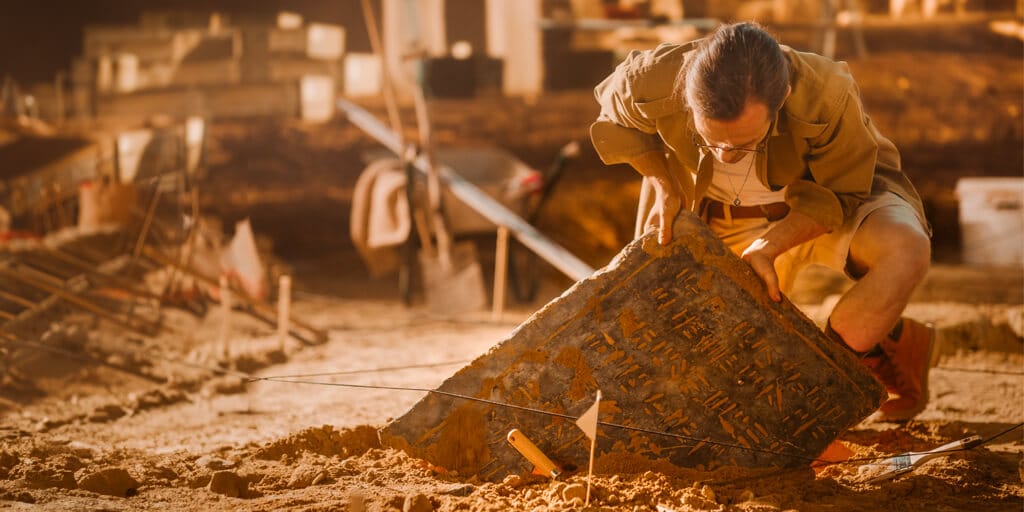The Bible vs. Other Religious Books Part 3 – Archeological Evidence

We begin by acknowledging that archeology should not be expected to either “prove” or “disprove” the Bible. That’s not its purpose. However, in their book Ready with An Answer, Drs. Ankerberg and Weldon explain the Archeological Evidence for the Bible:
“In what way does archeology confirm the biblical record? Primarily by demonstrating that it is trustworthy where it can be tested. Obviously, biblical claims cannot be tested everywhere. Archeology cannot be expected to confirm every statement of biblical history, geography, culture, etc., because the amount of information archeology has uncovered is still relatively small. Further, dealing as it does with material remains, archeology can hardly prove the spiritual claims of the Bible, since those claims must be established independently, by other means. Nor can archeology prove that literally everything in the Bible happened in just the way the Bible says it did. Again, the extensive amount of data necessary for such a confirmation is simply not available and probably never will be.”[1]
And:
“The significant point is this: when sufficient factual information becomes known, and is properly interpreted, it always confirms the biblical record. In cases where a discovery initially seems not to confirm the Bible, sufficient factual data is never encountered in order to disprove a biblical statement. Given the thousands of minute details in the Bible that archeology has the opportunity to disprove, this confirmation of the biblical record is striking.”[2]
We will mention just a few discoveries that have upheld the reliability of the Old Testament. The website Bible Archeology Report compiled a list of discoveries in an article entitled “Top Ten Discoveries in Biblical Archaeology Relating to the Old Testament,” they include discoveries that confirm biblical dates, kings, the proclamation by Cyrus recorded in Ezra 1:1-3, the relationship between Israel and Egypt, and Hezekiah’s Tunnel.[3]
Another article found on Crossway.org is entitled “10 Crucial Archaeological Discoveries Related to the Bible.” Here are listed the Rosetta Stone, the Dead Sea Scrolls, the Lakish Letters, and the Epic of Gilgamesh, among others. Of the Dead Sea Scrolls, the authors say,
“What did these caves contain? Over 800 fragmentary documents, mainly consisting of Hebrew writings on leather (with a few on parchment), including fragments of 190 biblical scrolls. Most of these are small, containing no more than one-tenth of a book; however, a complete Isaiah scroll has been found. Almost every OT book is present, and there are also other writings valued by the community that dwelt in those caves. It appears the earliest scrolls date to the mid-third century BC, and most to the first or second centuries BC.
“Perhaps the greatest contribution of this find is to our understanding of the transmission of the biblical text. It is encouraging to note that the differences are minimal between the OT texts of the Dead Sea Scrolls and various editions of the Hebrew texts produced a thousand years later and used today, involving the smallest textual details. The meaning of the text itself is not affected by these differences.”[4]
Archeology cannot, and does not claim to solve every problem passage we find in the Bible. Some problems are as a result of copyist errors that must be resolved by comparing manuscript copies to arrive at the most accurate translation. Other problems may exist because we misunderstand the culture in which the Bible was written. Some issues, as Ankerberg and Weldon said, are of a spiritual nature to which archeology cannot speak.
Still, it is encouraging to know that where archeology is able to confirm what the Bible says, it has done so. Why does that matter to us today? As Ankerberg and Weldon explain,
“The importance of archeological data in confirmation of the biblical record is evident when we understand that such material confirmation also leads one to have confidence in its spiritual teachings. Those who believe that the Bible is unreliable in historical matters can hardly be expected to accept its teachings in spiritual matters. To illustrate in a more mundane matter, a famous cookbook may promise culinary delights that are heavenly, but if the recipe ingredients are wrong, it won’t matter. Thus, ‘Although confirmation of one kind of truth (historical) does not demonstrate the validity of another kind of truth (theological), the veracity of the historical narrative of Scripture lends credence to the theological message. Those who do not accept the historical accuracy of the Bible find it easier to dismiss its theological claims.’”[5]
So, while archeology does not “prove” the Bible, it certain has confirmed many things, some of which had been long doubted by Bible critics and skeptics. More reasons to believe!
How about your holy book? Has it been confirmed by archeology, or have archeological discoveries actually contradicted what the holy book said? If so, how should you respond? Should you trust that book to tell you the truth about your faith and your future?
Go Deeper
- Iran, Israel and End Time Events – 2 DVD’s 3 Books – Package Offer
- The End of America? – Book
- Can We Still Believe in the Rapture? – Book
- Northern Storm Rising – Book
- John Ankerberg, John Weldon, Ready With An Answer For the Tough Questions About God (Eugene, OR: Harvest House Publishers,1997), p. 261, emphasis added. ↑
- Ibid, emphasis added. ↑
- To read more about these and other discoveries, visit https://biblearchaeologyreport.com/2019/01/12/top-ten-discoveries-in-biblical-archaeology-relating-to-the-old-testament/. ↑
- Emphasis added. Again, if this type of thing interests you particularly, you can read more at https://www.crossway.org/articles/10-crucial-archaeological-discoveries-related-to-the-bible/. See also, Armstrong Institute of Biblical Archaeology, “Top 10 Biblical Archaeology Discoveries of 2022,” https://armstronginstitute.org/841-top-10-biblical-archaeology-discoveries-of-2022. ↑
- Joseph P. Free, revised and expanded by Howard F. Vos, Archeology and Bible History (Grand Rapids: Zondervan, 1992), p. 13, quoted in Ankerberg and Weldon, Ready, p. 262. ↑








